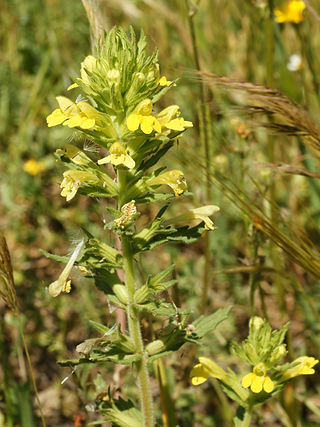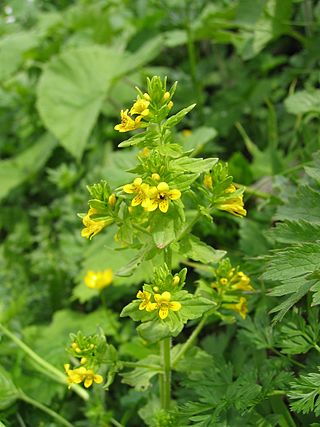
Lathraea (toothwort) is a small genus of five to seven species of flowering plants, native to temperate Europe and Asia. They are parasitic plants on the roots of other plants, and are completely lacking chlorophyll. They are classified in the family Orobanchaceae.

Odontites is a genus of flowering plants in the family Orobanchaceae.

Euphrasia, or eyebright, is a genus of about 215 species of herbaceous flowering plants in the family Orobanchaceae, with a cosmopolitan distribution. They are hemiparasitic on grasses and other plants. The common name refers to the plant's use in treating eye infections.

Melampyrum is a genus of about 20 species of herbaceous flowering plants in the family Orobanchaceae known commonly as cow wheat. They are native to temperate regions of the Northern Hemisphere. They are hemiparasites on other plants, obtaining water and nutrients from host plants, though some are able to survive on their own without parasitising other plants.

Rhinanthus is a genus of annual hemiparasitic herbaceous plants in the family Orobanchaceae, formerly classified in the family Scrophulariaceae. Its species are commonly known as rattles. The genus consists of about 30 to 40 species found in Europe, northern Asia, and North America, with the greatest species diversity in Europe.

The painted tree-rat is a species of spiny rat from Brazil, restricted to north-eastern Bahia in eastern Brazil. It is the only species in the genus Callistomys.
The tuft-tailed spiny tree rat is a spiny rat species from Brazil south of the Amazon River, where it has been found in grassland and gallery forest. It is the only species in the genus Lonchothrix. Very little is known about this rodent. It is small with an average adult weight of about 138 grams. It is nocturnal and solitary in habits.
Phyllomys is a genus of arboreal spiny rat, geographically restricted to the forests of eastern Brazil.

Mesomys is a genus of South American spiny rats in the family Echimyidae.

Echimys is a genus of the spiny rats family, the Echimyidae. Members of this genus are collectively called spiny tree-rats.

Euryzygomatomys is a genus of South American rodents, commonly called guiaras, in the family Echimyidae. It contains two extant and one fossil species, found in Argentina, Brazil and Paraguay. They are as follows:

Plagiodontia is a genus of rodent in the subfamily Capromyinae (hutias). All known species are endemic to the Caribbean island of Hispaniola.

Bartsia is a genus of flowering plants in the family Orobanchaceae.

Bellardia trixago is a species of flowering plant in the family Orobanchaceae. The only member of the monotypic genus Bellardia, it is known as trixago bartsia or Mediterranean lineseed. This plant is native to the Mediterranean Basin, but it is known in other places with similar climates, such as California and parts of Chile, where it is an introduced species and noxious weed.

Parentucellia is a small genus of flowering plants in the family Orobanchaceae containing about four species. They are known generally as glandweeds. The genus was named for Pope Nicholas V, whose surname was Parentucelli.
Clyomys is a South American rodent genus in the family Echimyidae. It contains two species, found in tropical savannas and grasslands from circa 100 m (300 ft) to 1,100 m (3,600 ft) elevation in central Brazil and eastern Paraguay.

Tozzia is a monotypic genus of flowering plants within the broomrape family Orobanchaceae. It contains a unique species, Tozzia alpina.

Hedbergia is a monotypic genus of flowering plants, initially classified in Scrophulariaceae, and now within the broomrape family Orobanchaceae. It contains a unique species, Hedbergia abyssinica. It is an afromontane genus, widespread in grasslands and scrubs of the mountains of tropical Africa, and known from Ethiopia, Zaire, Uganda, Kenya, Tanzania, Malawi, Nigeria, and Cameroons.

Hedbergia decurva, formerly Bartsia decurva, is a species of flowering plants in the family Orobanchaceae.
Hedbergia longiflora, formerly Bartsia longiflora, is a species of flowering plants in the family Orobanchaceae.
















